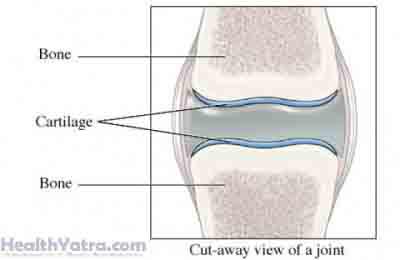Definition
An osteochondroma is the most common type of benign bone tumor. It arises from cartilage tissue in children and adolescents between the ages of 10 and 20, usually appearing on the long bones (arms and legs) and less often on the pelvic bones and wing bones (scapulae). An osteochondroma ordinarily stops growing when a person reaches full height.
Most tissue in the body can grow beyond normal limits and form a mass, also known as a tumor. Tumors come in two forms: benign and malignant. The malignancies which are referred to as cancer, rarely stop growing. The benign tumors reach a certain size and then stop.
Bones can host at least ten different benign tumors, some of which turn into cancers. Less than 1% of osteochondromas turn into a bone cancer called chondrosarcoma, usually in later years.

Causes
The cause of osteochondroma remains unknown. A hereditary form of the disease is presumably related to one or more gene mutations (see below).
Risk Factors
The following factors increase your chance of developing osteochondroma. If you have any of these risk factors, tell your doctor:
- Radiation treatment or exposure as a child
- Multiple hereditary exostoses—In this rare inherited condition, numerous osteochondromas develop throughout the skeletal system often leading to bone deformities, and the risk of cancer (chondrosarcoma) is increased to anywhere between 5%-30%.
Symptoms
If you experience any of these symptoms do not assume it is due to osteochondroma. These symptoms may be caused by other, more serious health conditions. If you experience any one of them, see your physician.
- A hard, bony lump, especially if it is in a long bone or the pelvis
- Lump:
- Painless and not tender, but the tissue around it may become irritated and painful
- Enlarging in size
- A long bone that breaks with less than the usual amount of force
Diagnosis
Your doctor will ask about your symptoms and medical history, and perform a physical exam. You will very likely be referred to an orthopedic surgeon for further diagnosis and treatment.
Tests may include the following:
- X-rays of the bone
- Bone scan using a radioactive tracer
- CT scan —an x-ray test that uses computers to make detailed images of the mass and surrounding tissue
- Angiography —X-rays, CT scan, or MRI scan using a dye injected into your body
Treatment
Treatment options include the following:
Leave It Alone
If the lump is not uncomfortable or likely to cause a fracture or other problem, and there is no evidence that it is malignant, it can be left alone. Your doctor may want to retest periodically.
Surgical Excision
If the lump is large, uncomfortable, in a dangerous location, or suspected of being cancerous, surgical removal is the treatment of choice. This involves a general or regional anesthetic and a few days in the hospital. If the bone is weakened by the surgery, the surgeon may need to rebuild it, and the recovery time may be extended to weeks or months.
Since remnants of the tumor may remain after surgery, your doctor may want to retest you every few years to make sure it doesn’t start to grow again.
Prevention
There are no preventive measures for osteochondroma.
